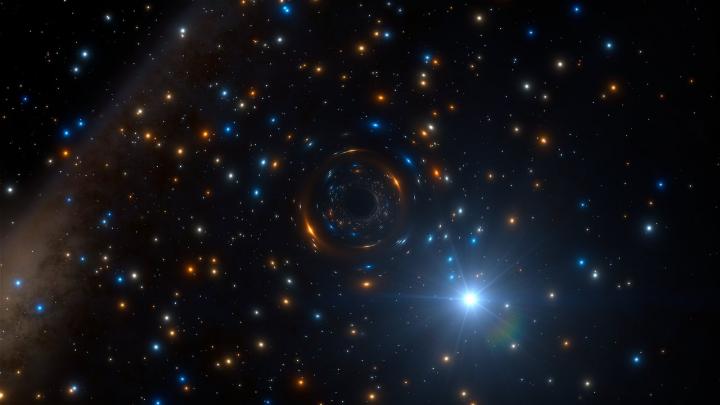Spotted: Black hole hiding in giant star cluster
An international team of astronomers led by the University of Göttingen witnessed a star in the globular cluster NGC 3201 acting “curious.” Boomeranged forwards and back, the star reached speeds of several hundred thousand kilometres per hour, with the pattern repeating every 167 days. It later became clear the star was only reacting to the presence of something much larger hiding in plain sight.
“It was orbiting something that was completely invisible, which had a mass more than four times the Sun. This could only be a black hole! The first one found in a globular cluster by directly observing its gravitational pull,” said, in a press release, lead author Benjamin Giesers of the new research published in Monthly Notices of the Royal Astronomical Society.
(Artist’s Impression of the Black Hole. Picture credit: ESO/L. Calçada)
Researchers used the MUSE instrument on ESO’s Very Large Telescope (VLT) in Chile, to measure the motions of multiple stars all at once, such as those in a globular cluster. Tens of thousands of stars are held within a cluster, a potential feeding ground for black holes, but not this. The inactive black hole at the heart of the cluster appeared to not be devouring surrounding matter and void of a glowing disk super heated dust.
Gieser concludes, “Until recently, it was assumed that almost all black holes would disappear from globular clusters after a short time and that systems like this should not even exist! But clearly this is not the case. Our discovery is the first direct detection of the gravitational effects of a stellar mass black hole in a globular cluster.”
For more science and technology articles, pick up the latest copy of How It Works from all good retailers or from our website now. If you have a tablet or smartphone, you can also download the digital version onto your iOS or Android device. To make sure you never miss an issue of How It Works magazine, subscribe today!
Other articles you may like:





